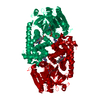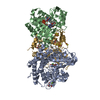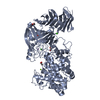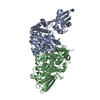[English] 日本語
 Yorodumi
Yorodumi- EMDB-2387: Structure and substrate induced conformational changes of the sec... -
+ Open data
Open data
- Basic information
Basic information
| Entry | Database: EMDB / ID: EMD-2387 | |||||||||
|---|---|---|---|---|---|---|---|---|---|---|
| Title | Structure and substrate induced conformational changes of the secondary citrate/sodium symporter CitS revealed by electron crystallography | |||||||||
 Map data Map data | 3D reconstruction of CitS in Sodium Acetate buffer, pH 4.5 | |||||||||
 Sample Sample |
| |||||||||
 Keywords Keywords | CitS / Secondary Transporter / Membrane Protein | |||||||||
| Function / homology | 2-hydroxycarboxylate transporter / 2-hydroxycarboxylate transporter, Proteobacteria/Firmicutes / 2-hydroxycarboxylate transporter family / citrate metabolic process / organic anion transmembrane transporter activity / symporter activity / membrane => GO:0016020 / plasma membrane / Citrate-sodium symporter Function and homology information Function and homology information | |||||||||
| Biological species |  Klebsiella pneumoniae (bacteria) Klebsiella pneumoniae (bacteria) | |||||||||
| Method | electron crystallography / cryo EM / negative staining / Resolution: 6.0 Å | |||||||||
 Authors Authors | Kebbel F / Kurz M / Arheit M / Gruetter MG / Stahlberg H | |||||||||
 Citation Citation |  Journal: Structure / Year: 2013 Journal: Structure / Year: 2013Title: Structure and substrate-induced conformational changes of the secondary citrate/sodium symporter CitS revealed by electron crystallography. Authors: Fabian Kebbel / Mareike Kurz / Marcel Arheit / Markus G Grütter / Henning Stahlberg /  Abstract: The secondary Na+/citrate symporter CitS of Klebsiella pneumoniae is the best-characterized member of the 2-hydroxycarboxylate transporter family. The recent projection structure gave insight into ...The secondary Na+/citrate symporter CitS of Klebsiella pneumoniae is the best-characterized member of the 2-hydroxycarboxylate transporter family. The recent projection structure gave insight into its overall structural organization. Here, we present the three-dimensional map of dimeric CitS obtained with electron crystallography. Each monomer has 13 a-helical transmembrane segments; six are organized in a distal helix cluster and seven in the central dimer interface domain. Based on structural analyses and comparison to VcINDY, we propose a molecular model for CitS, assign the helices, and demonstrate the internal structural symmetry. We also present projections of CitS in several conformational states induced by the presence and absence of sodium and citrate as substrates. Citrate binding induces a defined movement of a helices within the distal helical cluster. Based on this, we propose a substrate translocation site and conformational changes that are in agreement with the transport model of ‘‘alternating access’’. | |||||||||
| History |
|
- Structure visualization
Structure visualization
| Movie |
 Movie viewer Movie viewer |
|---|---|
| Structure viewer | EM map:  SurfView SurfView Molmil Molmil Jmol/JSmol Jmol/JSmol |
| Supplemental images |
- Downloads & links
Downloads & links
-EMDB archive
| Map data |  emd_2387.map.gz emd_2387.map.gz | 1.5 MB |  EMDB map data format EMDB map data format | |
|---|---|---|---|---|
| Header (meta data) |  emd-2387-v30.xml emd-2387-v30.xml emd-2387.xml emd-2387.xml | 11.4 KB 11.4 KB | Display Display |  EMDB header EMDB header |
| Images |  EMD_2387.tif EMD_2387.tif | 219.7 KB | ||
| Archive directory |  http://ftp.pdbj.org/pub/emdb/structures/EMD-2387 http://ftp.pdbj.org/pub/emdb/structures/EMD-2387 ftp://ftp.pdbj.org/pub/emdb/structures/EMD-2387 ftp://ftp.pdbj.org/pub/emdb/structures/EMD-2387 | HTTPS FTP |
-Validation report
| Summary document |  emd_2387_validation.pdf.gz emd_2387_validation.pdf.gz | 227.7 KB | Display |  EMDB validaton report EMDB validaton report |
|---|---|---|---|---|
| Full document |  emd_2387_full_validation.pdf.gz emd_2387_full_validation.pdf.gz | 226.8 KB | Display | |
| Data in XML |  emd_2387_validation.xml.gz emd_2387_validation.xml.gz | 5 KB | Display | |
| Arichive directory |  https://ftp.pdbj.org/pub/emdb/validation_reports/EMD-2387 https://ftp.pdbj.org/pub/emdb/validation_reports/EMD-2387 ftp://ftp.pdbj.org/pub/emdb/validation_reports/EMD-2387 ftp://ftp.pdbj.org/pub/emdb/validation_reports/EMD-2387 | HTTPS FTP |
-Related structure data
| Related structure data |  4bpqMC M: atomic model generated by this map C: citing same article ( |
|---|---|
| Similar structure data |
- Links
Links
| EMDB pages |  EMDB (EBI/PDBe) / EMDB (EBI/PDBe) /  EMDataResource EMDataResource |
|---|
- Map
Map
| File |  Download / File: emd_2387.map.gz / Format: CCP4 / Size: 3.7 MB / Type: IMAGE STORED AS FLOATING POINT NUMBER (4 BYTES) Download / File: emd_2387.map.gz / Format: CCP4 / Size: 3.7 MB / Type: IMAGE STORED AS FLOATING POINT NUMBER (4 BYTES) | ||||||||||||||||||||||||||||||||||||||||||||||||||||||||||||||||||||
|---|---|---|---|---|---|---|---|---|---|---|---|---|---|---|---|---|---|---|---|---|---|---|---|---|---|---|---|---|---|---|---|---|---|---|---|---|---|---|---|---|---|---|---|---|---|---|---|---|---|---|---|---|---|---|---|---|---|---|---|---|---|---|---|---|---|---|---|---|---|
| Annotation | 3D reconstruction of CitS in Sodium Acetate buffer, pH 4.5 | ||||||||||||||||||||||||||||||||||||||||||||||||||||||||||||||||||||
| Projections & slices | Image control
Images are generated by Spider. | ||||||||||||||||||||||||||||||||||||||||||||||||||||||||||||||||||||
| Voxel size | X=Y=Z: 1 Å | ||||||||||||||||||||||||||||||||||||||||||||||||||||||||||||||||||||
| Density |
| ||||||||||||||||||||||||||||||||||||||||||||||||||||||||||||||||||||
| Symmetry | Space group: 1 | ||||||||||||||||||||||||||||||||||||||||||||||||||||||||||||||||||||
| Details | EMDB XML:
CCP4 map header:
| ||||||||||||||||||||||||||||||||||||||||||||||||||||||||||||||||||||
-Supplemental data
- Sample components
Sample components
-Entire : CitS dimer
| Entire | Name: CitS dimer |
|---|---|
| Components |
|
-Supramolecule #1000: CitS dimer
| Supramolecule | Name: CitS dimer / type: sample / ID: 1000 / Oligomeric state: 2 / Number unique components: 1 |
|---|---|
| Molecular weight | Theoretical: 95 KDa |
-Macromolecule #1: CitS
| Macromolecule | Name: CitS / type: protein_or_peptide / ID: 1 / Number of copies: 1 / Oligomeric state: 2 / Recombinant expression: Yes |
|---|---|
| Source (natural) | Organism:  Klebsiella pneumoniae (bacteria) / Location in cell: inner membrane Klebsiella pneumoniae (bacteria) / Location in cell: inner membrane |
| Molecular weight | Theoretical: 95 KDa |
| Recombinant expression | Organism:  |
| Sequence | UniProtKB: Citrate-sodium symporter / GO: membrane => GO:0016020 |
-Experimental details
-Structure determination
| Method | negative staining, cryo EM |
|---|---|
 Processing Processing | electron crystallography |
| Aggregation state | 2D array |
- Sample preparation
Sample preparation
| Concentration | 1.35 mg/mL |
|---|---|
| Buffer | pH: 4.5 Details: 20 mM sodium acetate, pH 4.5, 500 mM NaCl, 15 mM MgCl2, 2 mM DTT, 2 mM NaN3 |
| Staining | Type: NEGATIVE Details: 20 mM sodium acetate, pH 4.5, 200 mM NaCl, 15 mM MgCl2, 2 mM DTT, 2 mM NaN3 |
| Grid | Details: 400 mesh Co grid with 2 micrometer holes from Quantifoil, covered with a very thin additional continuous carbon film |
| Vitrification | Cryogen name: ETHANE / Chamber humidity: 95 % / Chamber temperature: 80 K / Instrument: FEI VITROBOT MARK IV / Method: Blot for 4.5 seconds |
| Details | Dialysis |
| Crystal formation | Details: Dialysis |
- Electron microscopy
Electron microscopy
| Microscope | FEI/PHILIPS CM200FEG |
|---|---|
| Temperature | Min: 85 K / Max: 90 K / Average: 87 K |
| Details | Pre-exposure recorded on TVIPS-F416 of 0.1 ms, to reduce beam-induced resolution loss in subsequent image on film |
| Date | Dec 31, 2012 |
| Image recording | Category: FILM / Film or detector model: KODAK SO-163 FILM / Digitization - Scanner: PRIMESCAN / Digitization - Sampling interval: 5 µm / Number real images: 79 / Average electron dose: 6 e/Å2 / Od range: 1.2 / Bits/pixel: 16 |
| Tilt angle min | 0 |
| Electron beam | Acceleration voltage: 200 kV / Electron source:  FIELD EMISSION GUN FIELD EMISSION GUN |
| Electron optics | Calibrated magnification: 50000 / Illumination mode: FLOOD BEAM / Imaging mode: BRIGHT FIELD / Cs: 2 mm / Nominal defocus max: 2.5 µm / Nominal defocus min: 0.3 µm / Nominal magnification: 50000 |
| Sample stage | Specimen holder model: GATAN LIQUID NITROGEN / Tilt angle max: 45 / Tilt series - Axis1 - Min angle: 0 ° / Tilt series - Axis1 - Max angle: 45 ° |
- Image processing
Image processing
| Details | Images were unbent using 2dx. |
|---|---|
| Final reconstruction | Resolution.type: BY AUTHOR / Resolution: 6.0 Å / Resolution method: OTHER / Software - Name: 2dx |
| Crystal parameters | Unit cell - A: 96 Å / Unit cell - B: 106 Å / Unit cell - C: 200 Å / Unit cell - γ: 90 ° / Unit cell - α: 90.0 ° / Unit cell - β: 90.0 ° / Plane group: P 2 21 21 |
 Movie
Movie Controller
Controller











 Z (Sec.)
Z (Sec.) Y (Row.)
Y (Row.) X (Col.)
X (Col.)





















